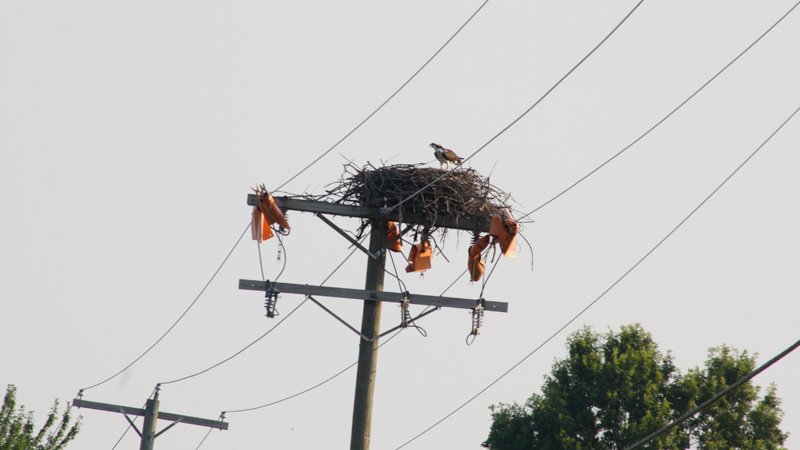Power couple: FirstEnergy, big birds coexist

By ED RUNYAN
runyan@vindy.com
BRISTOLVILLE
High atop a power pole in Bristol Township, an osprey nest stands out in a rural area of homes and fields.
Not only does it catch the eye because there is a large bird nest on top, but all around the nest are pieces of bright orange rubber.
Lauren Siburkis, a FirstEnergy spokeswoman, says it is one of two active osprey nests on Ohio Edison power poles in the Mahoning Valley and one of about 16 to 20 such nests that occur on Ohio Edison and Penn Power poles in a region of about 35 counties in Northeast Ohio and Western Pennsylvania each year. The other Mahoning Valley location is in the Salem/Alliance area.
Siburkis said FirstEnergy plans to remove the nests once the ospreys leave and migrate south for the winter.
“The orange markers you see on the pole are rubber covers we put over conductors to insulate the equipment and protect the nesting birds,” she said of the Bristol nest. “They are meant to be a temporary fix until our crews can permanently remove the nest from our pole when it’s ... empty.”
Siburkis said the company will work with state wildlife officials during the removal. Ospreys make up the largest percentage of such nests, but red tail hawks and eagles also make up a percentage.
Over the past five years, the osprey population has spiked significantly in Northeast Ohio and Western Pennsylvania. ”Unfortunately, electrical equipment seems to be prime real estate for the birds, which not only jeopardizes their well-being but also causes power outages,” Siburkis said.
A man living near the nest, who did not want to be identified, said he has enjoyed watching the birds and listening to their calls. “You pick up their sound,” he said. “It’s some kind of communication with the other ospreys.”
FirstEnergy says it is among the first — if not the first — electric utility companies using drones to complete nest inspections on utility poles. Drones offer a fast and safe way to survey locations where birds have nested on utility poles and other electric equipment, Siburkis said.
The drones prevent a line worker from having to be lifted to the nest to inspect it. “This is a win-win because it will help protect the birds and enhance our customer service reliability,” she said.
“We were initially concerned the drone would startle the birds, but they were more frightened by the people on the ground and didn’t seem to notice the drone in the sky,” says Amy Ruszala, a FirstEnergy environmental scientist.
Images from the drone are viewed by FirstEnergy workers. If the image shows a nest without eggs, a line worker in an aerial bucket truck confirms it is empty and removes the nest. In most cases, an active nest containing eggs cannot be disturbed.
“If a nest with eggs is situated on our equipment and poses a serious threat to the birds’ safety and our service reliability, we will work with state wildlife officials to install a special nesting box to provide a safer home,” Ruszala said.
Last winter, Penn Power also installed new, fiberglass crossarms on nearly two dozen utility poles along the state Route 18 causeway over the Shenango River Lake in Mercer County.
Penn Power line workers replaced wooden, double crossarms with a new, single fiberglass crossarm. Crossarms are mounted on the top of a utility pole to hold up power lines or other equipment. Unlike a double crossarm, the single crossarm design does not entice an osprey because it is not large or stable enough to hold the nest, which can measure up to three feet in width.
“Ospreys typically arrive in Pennsylvania in late March and return to the same nesting sites from the year before,” said Ruszala.
Ospreys prefer to nest near large bodies of water in a large, bulky pile of sticks, put together on the top of a tall tree, a rocky ledge or utility pole crossarms. An earlier Penn Power effort was to install a nesting platform near Shenango Lake for the birds, but they didn’t take to it.
The FirstEnergy Foundation also recently donated $5,000 to the Erie Bird Observatory to build nesting platforms in its service area this year. The nesting platforms will be installed by FirstEnergy line workers this fall or winter after empty nests are located.
Penn Power is a subsidiary of Akron-based FirstEnergy and serves customers in counties such as Crawford, Lawrence and Mercer counties. FirstEnergy subsidiary Ohio Edison serves Ohio counties including Trumbull, Mahoning, Columbiana, Portage, Stark, Geauga and Ashtabula.
 43
43
